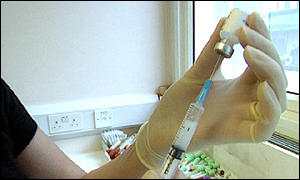![]()
Write us!
[email protected]
December 2003 • Vol 3, No. 11 •
Cuban Vaccine to Help Poor Kids

Cuban researchers have developed the first synthetic vaccine against a bacteria that causes pneumonia and meningitis, a breakthrough aimed at lowering the cost of immunizing children in poorer countries.
The vaccine protects against haemophilus influenzae type B, a bacteria that causes upper respiratory infections, mainly in children up to five years of age. The disease is a leading cause of meningitis, an infection of the brain and spinal cord coverings that can cause brain damage, deafness or death.
The research on the new vaccine, which has already been tested and put into production in Cuba, will be presented on Wednesday to experts from the world over at a biotechnology congress in Havana.
This is the first vaccine for humans made with a chemically produced antigen, Cuban scientists said. The available, conventional vaccine is made using a difficult and more costly process of growing antigens in a bacterial culture.
“It took us six years,” said Dr. Vicente Verez, head of the University of Havana’s Synthetic Antigens Laboratory. “But what could be more precious for society than to have healthy 2-month-old babies,” he said.
Poor nations that depend on multinational pharmaceutical companies for the vaccine—now costing $3 a dose—will now have a less expensive alternative, Verez said.
The disease has been almost erased in the United States, the U.S. Centers for Disease Control said. But it remains a problem in developing countries where the cost of the vaccine has been a barrier to widespread immunization.
Clinical trials conducted in the central Cuban province of Camaguey, first on adult volunteers, then on four-year-old children and finally on babies, showed a 99.7 percent success rate in developing the required antibodies.
The technology for the new vaccine was patented in 1999 by the University of Ottawa and the University of Havana. The Canadians discovered how to simplify crucial chemical reactions and Cuba applied the method on a larger scale, Verez said.
Cuba could not afford the conventional vaccine when it appeared a decade ago. The Cuban economy was in deep crisis after the collapse of its ally the Soviet Union. So Cuba turned to its own medical and biotechnology industry, one of the most advanced in the Third World.
Havana has invested millions of dollars in the industry since the 1980s, achieving major successes such as the discovery of a recombinant vaccine for meningitis B, which has been used in Latin American countries and was licensed to GlaxoSmithKline for sale in Europe and possibly the United States. It has also developed a hepatitis B vaccine that is exported to more than 30 countries.
Haemophilus influenzae type B is the main cause of almost half of the infections in children under five in the world and kills 500,000 children a year, mostly in developing countries, according to UNICEF.
— Reuters, Nov. 23, 2003
Write us
[email protected]